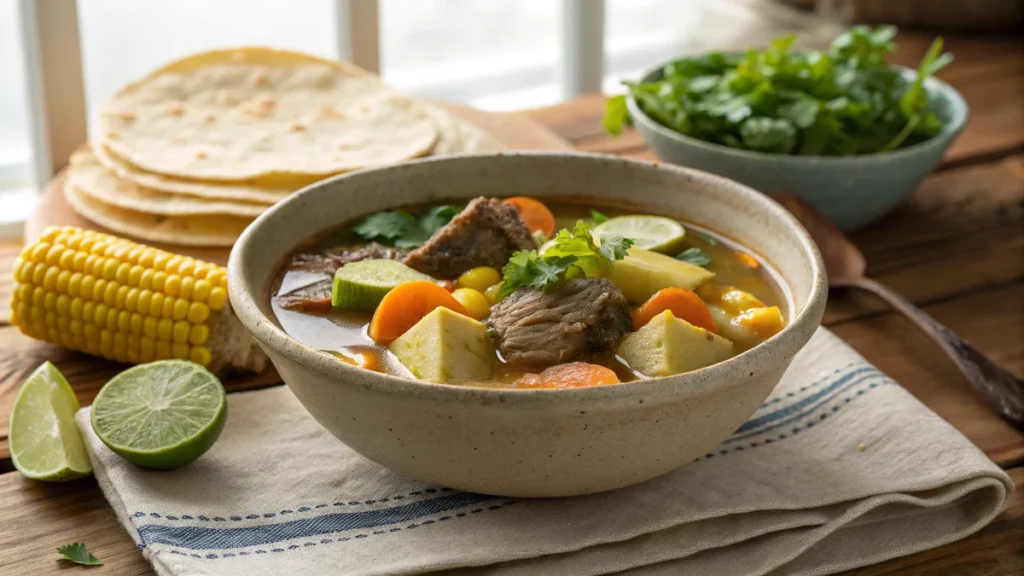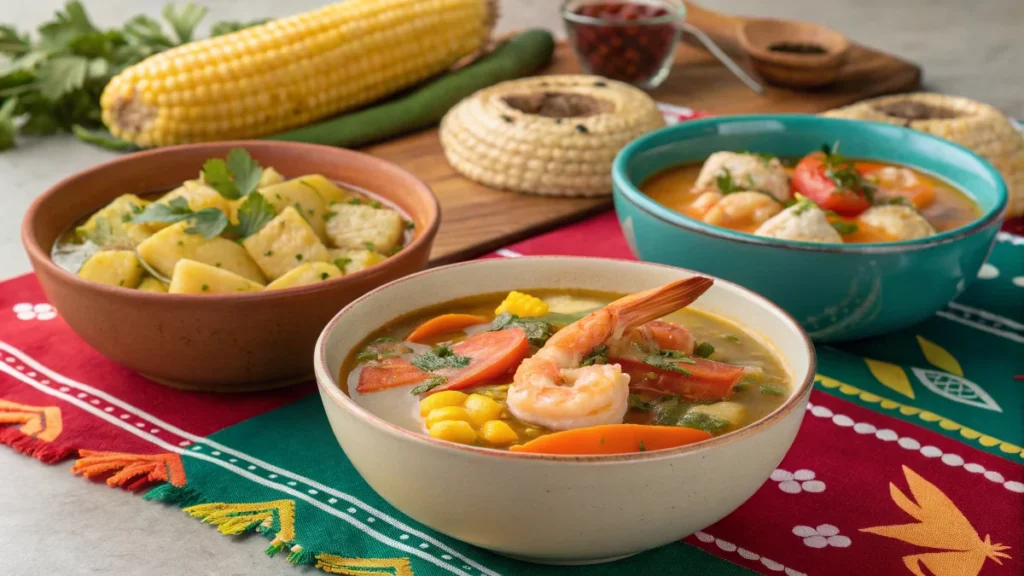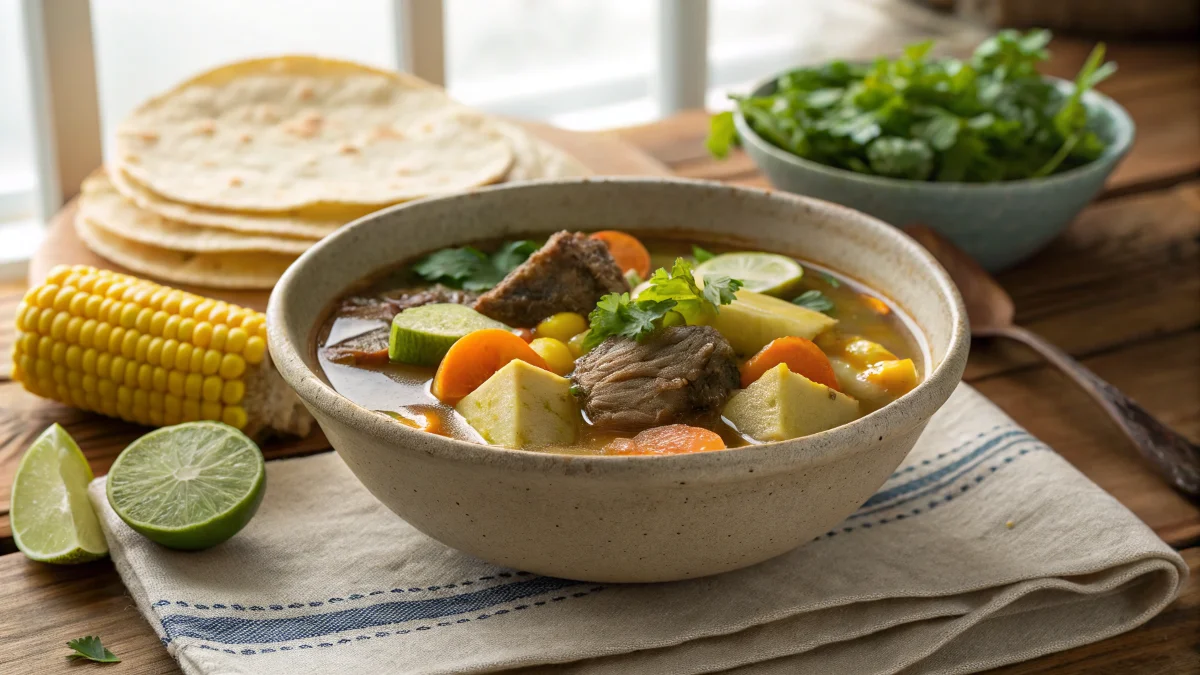Caldo de Res, or Mexican beef soup, is a traditional dish renowned for its hearty flavors and cultural significance. With tender beef and fresh vegetables simmered in a flavorful broth, it has been a beloved comfort food for centuries. The Caldo de Res Origin reflects the deep culinary traditions of Mexican cuisine, where wholesome ingredients come together to create nourishing meals. Understanding the Caldo de Res Origin highlights its evolution as a dish that blends indigenous and Spanish influences, making it a staple in Mexican households and a symbol of comfort and tradition.
To delve deeper into this iconic dish, explore Caldo de Res: The Hearty Mexican Soup That Will Warm Your Soul. This resource offers insights into the recipe and tips for perfecting this comforting classic.

Table of Contents
The Pre-Columbian Roots of Caldo de Res
Indigenous Culinary Practices
Before the arrival of the Spanish, indigenous communities in Mexico were already well-versed in the art of cooking stews and broths. Using clay pots and open fires, they crafted warm and flavorful meals with native ingredients. The Caldo de Res Origin can be traced back to these traditions, as corn, squash, beans, and chiles were staples in their diets, forming the basis of soups and stews that nourished families for generations.
Soup-Like Dishes in Pre-Hispanic Times
While beef wasn’t part of their diet, indigenous Mexicans often prepared hearty broths using wild game and native vegetables. These early dishes showcased their expertise in slow-cooking techniques, which preserved the nutritional value of the ingredients and created complex, rich flavors. These cooking methods played a significant role in the Caldo de Res Origin, laying the groundwork for the dish’s future evolution into a beloved Mexican classic.
The Spanish Influence on Caldo de Res
The Arrival of New Ingredients
The Spanish conquest of the Americas in the 16th century introduced a wealth of new ingredients and cooking traditions. Among the most significant additions to Mexican cuisine were cattle, onions, garlic, and cilantro. Beef, a key ingredient in caldo de res, became a staple in Mexican cooking, with cuts like the beef shank prized for their flavor and affordability.
Fusion of Spanish and Indigenous Traditions
The indigenous people of Mexico adapted these new ingredients into their existing culinary practices, blending native flavors with Spanish techniques. This fusion of cuisines gave rise to the Caldo de Res Origin, resulting in the creation of new dishes. The slow-simmered beef broth combined with fresh vegetables became a perfect example of how the blending of two cultures could produce something extraordinary and enduring.
Regional Variations of Caldo de Res
Northern Mexico
The indigenous people of Mexico adapted these new ingredients into their existing culinary practices, blending native flavors with Spanish techniques. This fusion of cuisines gave rise to the Caldo de Res Origin, resulting in the creation of new dishes. The slow-simmered beef broth combined with fresh vegetables became a perfect example of how the blending of two cultures could produce something extraordinary and enduring.
Southern Mexico
The southern regions of Mexico put their own spin on caldo de res by incorporating tropical vegetables such as plantains, yucca, and chayote. These ingredients give the soup a distinctive flavor and reflect the diverse agricultural bounty of the region.
Coastal Variations
Coastal areas in Mexico often adapt caldo recipes by replacing beef with seafood like shrimp or fish. These variations showcase the dish’s versatility and its ability to reflect local ingredients and culinary traditions.
For a step-by-step guide to mastering another kitchen staple, check out How to Cook Pasta Step by Step: A Simple Guide to Perfect Pasta. This resource ensures your pasta turns out flawless every time.

The Role of Caldo de Res in Mexican Culture
A Symbol of Family and Tradition
Caldo de res is more than just a dish—it’s a symbol of family, community, and tradition in Mexican culture. The Caldo de Res Origin is deeply rooted in the idea of togetherness, as preparing it is often a communal activity. Family members come together to chop vegetables, season the broth, and share stories during the cooking process. Traditionally served on weekends or special occasions, this dish has become a cornerstone of familial bonds, embodying love, connection, and shared heritage.
A Comfort Food for All Occasions
The warming, nourishing nature of caldo de res has cemented its status as a comfort food. It’s a dish that brings people together, whether it’s served during a family meal, to celebrate a special event, or as a remedy for colds and other illnesses. In Mexican households, caldo de res is often seen as an expression of love and care.
Where Does Caldo Come From?
The Origins of the Word
The term “caldo” is derived from the Latin word calidus, meaning warm or hot. In Spanish, it refers to broth or soup, highlighting its comforting and nourishing qualities. The Caldo de Res Origin is tied to this term, which was introduced to Mexico during the Spanish colonial period. Over time, it became fully integrated into the local culinary lexicon, representing not just a type of dish but also a symbol of warmth and hospitality in Mexican cuisine.
Caldo in the Mexican Context
While the word “caldo” has its roots in Spanish cuisine, the concept of hearty soups and broths existed in Mexico long before the arrival of the Spanish. Indigenous stews and soups were rich in flavor and nutrition, making the transition to incorporating European ingredients seamless. Over time, caldo de res evolved into a uniquely Mexican dish, blending the culinary traditions of both cultures.
Part 6: How Healthy Is Caldo de Res? (250 words)
Nutritional Powerhouse
Caldo de res is celebrated not only for its rich flavor but also for its exceptional nutritional benefits. The Caldo de Res Origin emphasizes the use of beef shank, a key ingredient that provides high-quality protein essential for muscle repair and overall body function. Additionally, the beef shank contains collagen and marrow, which are known to support joint health, improve skin elasticity, and aid digestion, making this dish both hearty and healthful.
Vegetables such as carrots, zucchini, corn, and potatoes contribute essential vitamins and minerals to caldo de res. Carrots are rich in vitamin A, supporting eye health, while zucchini provides antioxidants that help protect the body from free radicals. Corn adds dietary fiber, promoting a healthy gut and improved digestion. These ingredients, rooted in the Caldo de Res Origin, come together to create a balanced, nutritious meal that embodies the tradition of wholesome and hearty cooking.
Low in Calories, High in Satisfaction
Despite its hearty nature, Caldo de Res Origin showcases how the dish can be a low-calorie option when prepared with lean cuts of beef and minimal added fats. The combination of high-quality protein, fiber-rich vegetables, and a hydrating broth helps keep you full and satisfied, making it an excellent choice for those looking to enjoy a flavorful meal while managing their calorie intake.
Digestive and Immune Boost
The slow-cooking process of caldo de res draws out nutrients from the beef shank, creating a gelatin-rich broth that supports gut health and strengthens the immune system. The warmth of the soup also helps to soothe colds and sore throats, making it a dish that is not only deeply nourishing but also incredibly comforting. The Caldo de Res Origin emphasizes these restorative qualities, highlighting its role as both a hearty meal and a traditional remedy.
For more culinary inspiration, explore Pasta Recipes: A Comprehensive Guide to Delicious Dishes. This guide offers creative ideas to elevate your pasta-making skills and expand your recipe collection.

What Does Caldo Mean in Mexico?
Cultural Significance of “Caldo”
In Mexico, “caldo” is more than just a dish—it’s a symbol of warmth, comfort, and hospitality deeply tied to the Caldo de Res Origin. Derived from the Spanish word for broth, the term embodies the essence of Mexican family traditions. A steaming bowl of caldo is often linked to home-cooked meals prepared with love and care, reflecting the importance of togetherness and nurturing in Mexican culture.
A Dish for the Soul
Mexicans often regard caldo as a remedy for both the body and the spirit. Whether it’s caldo de res or another variation, the dish is cherished for its ability to bring comfort during difficult times. It’s the meal people turn to when they’re feeling sick, homesick, or simply in need of the warmth and connection that only a traditional, family-prepared dish can provide. The Caldo de Res Origin reinforces this connection, making it more than just food—it’s a symbol of care and belonging.
Caldo in Everyday Life
Caldo de res is not just a seasonal dish—it’s a year-round staple in Mexican households. Rooted in the Caldo de Res Origin, it often takes center stage during Sunday family gatherings, where loved ones come together to share a meal and strengthen bonds. This tradition highlights the dish’s importance in fostering familial connections and preserving cultural ties, making it a cherished symbol of unity and togetherness in Mexican culture.
Caldo de Res: A Global Favorite
Beyond Mexico’s Borders
Thanks to the global spread of Mexican cuisine, the Caldo de Res Origin has brought this beloved dish international recognition. In countries with large Mexican communities, such as the United States, caldo de res has become a staple in Mexican restaurants. Its hearty and comforting nature resonates with people from all walks of life, making it a popular and cherished choice around the world.
Adaptations Around the World
As caldo de res has traveled beyond Mexico, it has been adapted to suit various tastes and dietary preferences. Some chefs enrich the broth with bone marrow for added depth and flavor, while others replace beef with chicken or plant-based proteins to accommodate vegetarians. These creative adaptations honor the Caldo de Res Origin, preserving its comforting essence while making it accessible to a broader and more diverse audience around the world.
A Representation of Mexican Culture
Caldo de res often acts as an ambassador for Mexican cuisine, showcasing the Caldo de Res Origin and introducing newcomers to the authentic flavors of the country. Its simple yet flavorful ingredients make it approachable for first-timers, while its deep cultural history and tradition add richness and meaning to its universal appeal.
FAQs About Caldo de Res
Where Does Caldo Come From?
The concept of caldo originates from Spanish cuisine, where the term broadly refers to broths or soups. In Spain, caldos were often prepared with a variety of meats, vegetables, and seasonings, creating hearty and nourishing meals. During the 16th century, Spanish settlers brought this culinary tradition to Mexico, influencing the Caldo de Res Origin and paving the way for the fusion of Spanish techniques with indigenous Mexican ingredients and flavors.
In Mexico, the concept of caldo was reimagined through a fusion of Spanish culinary traditions and indigenous cooking techniques. The Spanish idea of broth was enriched with locally available ingredients like corn, squash, and chiles, creating dishes that are uniquely Mexican. Among these, caldo de res stands out as a remarkable representation of this blend, embodying the Spanish influence while highlighting the creativity and resourcefulness of Mexican cuisine. The Caldo de Res Origin reflects this harmonious combination, making it a true cultural and culinary icon.
How Healthy Is Caldo de Res?
Caldo de res is not only rich in flavor but also a nutritional powerhouse, deeply connected to the Caldo de Res Origin. The beef shank is an excellent source of protein, iron, and collagen, which are vital for muscle repair, immune support, and joint health. The slow-cooking process extracts these nutrients into the broth, creating a dish that is both delicious and incredibly nourishing.
With the addition of fresh vegetables like carrots, zucchini, and potatoes, the soup becomes even more nutritious. These veggies supply antioxidants, vitamins A and C, and dietary fiber, contributing to overall health and aiding digestion. The warm broth is hydrating and soothing, making caldo de res a great choice for those recovering from illness or simply craving a comforting, low-calorie meal.
For a quick, healthy snack option, check out Are chicken tacos healthy for you? and learn how you can make your favorite taco dish more nutritious.
What Does Caldo Mean in Mexico?
In Mexico, “caldo” refers to any type of broth or soup, but its meaning goes beyond just a meal. Deeply tied to the Caldo de Res Origin, caldo symbolizes comfort, care, and connection. It is closely associated with family traditions, where large pots of soup are prepared and shared during gatherings. Caldo de res, in particular, represents hospitality, warmth, and the importance of togetherness in Mexican culture, making it a cherished symbol of love and community.
Whether it’s served on a cold day, during a celebration, or as a remedy for illness, caldo is much more than food—it’s an expression of love and community.
Where Is Caldo From?
Caldo, as a culinary concept, originates from Spanish cuisine, where hearty broths were a staple of traditional meals. However, the Caldo de Res Origin as we know it today is distinctly Mexican. Its creation resulted from the fusion of Spanish cooking techniques with indigenous Mexican ingredients and flavors, giving rise to a dish that perfectly embodies the rich cultural and culinary heritage of Mexico.
The use of beef shank, introduced by the Spanish, combined with native ingredients like corn and chiles, highlights the Caldo de Res Origin as a true culinary fusion. Over time, this dish has evolved to reflect the diverse regional tastes of Mexico, adapting to local ingredients and preferences. Today, caldo de res stands as a testament to the country’s rich history and cultural heritage, embodying the unique blend of indigenous and Spanish influences.
Conclusion: The Legacy of Caldo de Res Origin
Caldo de res is more than just a comforting bowl of soup—it’s a symbol of Mexico’s rich cultural heritage, culinary traditions, and generational pride. Rooted in indigenous cooking practices and later shaped by Spanish flavors and techniques, the Caldo de Res Origin showcases the harmonious blending of history and flavor. This beloved dish is a staple in Mexican households, representing warmth, love, and togetherness. Whether served during family gatherings, as a remedy for illness, or as a centerpiece for celebrations, each bowl of caldo de res carries a story of resilience, cultural pride, and the timeless value of nourishing meals crafted with care.
The beauty of caldo de res lies not only in its flavor but also in its adaptability. Ingredients like beef shanks, fresh vegetables, and fragrant herbs come together in a rich, gelatinous broth that is both hearty and healing. It is a dish that invites creativity and regional twists, ensuring it remains relevant and cherished across generations and geographies.
For tips on how to fully enjoy this traditional dish, visit How to Eat Caldo de Res: A Complete Guide to Savoring This Mexican Dish. This guide explores the best ways to serve, pair, and enjoy caldo de res, offering insights to help you appreciate the dish’s rich flavors and cultural significance.

